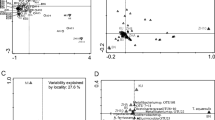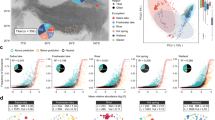Abstract
Habitability is defined as an ability of an organism to inhabit different environments. Habitability of organisms, however, cannot be inferred from analyses such as a whole genome or community structures. A recently developed database, the MetaMetaDB, gives us information from what kind of environments one particular 16S rRNA sequence data has ever been obtained, and thus enables us to infer the habitability of the bacterium in question. In order to check the applicability of this database to study the habitability of aquatic bacteria, samples collected at two Naka River stations, one estuarine station from Naka River Estuary, two coastal stations at Oarai in Ibaraki Prefecture, Japan and one station in the Kuroshio Current of the western North Pacific were examined. The phylotypes were tracked against the MetaMetaDB and it was reasonably found that the low-salinity stations were dominated by sequences with “freshwater and groundwater”, “human” and “wastewater” habitat identities, while the high-salinity stations were dominated by those with a “marine” identity. The phylotypes of low-salinity stations with a particular habitat identity were absent or rare in the high-salinity stations and vice versa. The MetaMetaDB also showed that sequences of Cyanobacteria or related phylogenetic groups may be present in the human gut, as well as the probable distribution of the relatives (ancestors/descendants/siblings) of some bacteria. These overall findings proved that the MetaMetaDB is useful as a new tool to infer microbial habitability and it gives us new information on the possible origin and ecology of microorganisms in the environments.




Similar content being viewed by others
References
Acinas SG, Rodrı ́guez-Valera F, Pedro ́s-Alio ́ C (1997) Spatial and temporal variation in marine bacterioplankton diversity as shown by RFLP finger-printing of PCR amplified 16S rDNA. FEMS Microbiol Ecol 24:27–40
Amaral-Zettler L, Artigas LF, Baross J et al (2010) A global census of marine life. In: McIntyre AD (ed) Life in the World’s Oceans: diversity, distribution, and abundance. Wiley-Blackwell, Oxford, pp 221–245
Baek K, Jo H, Choi A, Kang I, Cho J-C (2014) Ulvibacter marinus sp. nov., isolated from coastal seawater. Int J Syst Evol Microbiol 64:2041–2046
Bergey DH, Harrison FC, Breed RS, Hammer BW, Huntoon FM (eds) (1923) Bergey’s manual of determinative bacteriology. Williams and Wilkins, Baltimore
Bernardet JF, Segers P, Vancanneyt M, Berthe F, Kersters K, Vandamme P (1996) Cutting a Gordian knot: emended classification and description of the genus Flavobacterium, emended description of the family Flavobacteriaceae, and proposal of Flavobacterium hydatis nom. nov. (basonym, Cytophaga aquatilis Strohl and Tait 1978). Int J Syst Bacteriol 46:128–148
Cole JR, Wang Q, Cardenas E, Fish J, Chai B et al (2009) The Ribosomal Database Project: improved alignments and new tools for rRNA analysis. Nucleic Acids Res 37:D141–D145
Cottrell MT, Kirchman DL (2003) Contribution of major bacterial groups to bacterial biomass production (thymidine and leucine incorporation) in the Delaware estuary. Limnol Oceanogr 48:168–178
Crespo BG, Pommier T, Fernández Gómez B, Pedrós Alió C (2013) Taxonomic composition of the particle-attached and free-living bacterial assemblages in the Northwest Mediterranean Sea analyzed by pyrosequencing of the 16S rRNA. Microbiologyopen 2(4):541–552
Crump BC, Armbrust EV, Baross JA (1999) Phylogenetic analysis of particle-attached and free-living bacterial communities in the Columbia River, its estuary, and the adjacent coastal ocean. Appl Environ Microbiol 65:3192–3204
Crump BC, Hopkinson CS, Sogin ML, Hobbie JE (2004) Microbial biogeography along an estuarine salinity gradient: combined influences of bacterial growth and residence time. Appl Environ Microbiol 70:1494–1505
DeLong EF, Franks DG, Alldredge AL (1993) Phylogenetic diversity of aggregate-attached vs. free-living marine bacterial assemblages. Limnol Oceanogr 38:924–934
DeLong EF, Preston CM, Mincer T et al (2006) Community genomics among stratified microbial assemblages in the ocean’s interior. Science 311:496–503
DeSantis TZ, Hugenholtz P, Larsen N, Rojas M, Brodie EL et al (2006) Greengenes, a chimera-checked 16S rRNA gene database and workbench compatible with ARB. Appl Environ Microbiol 72:5069–5072
Di Rienzi SC, Sharon I, Wrighton KC, Koren O, Hug LA et al (2013) The human gut and groundwater harbor non-photosynthetic bacteria belonging to a new candidate phylum sibling to Cyanobacteria. eLife 2:e01102
Edgar RC, Haas BJ, Clemente JC, Quince C, Knight R (2011) UCHIME improves sensitivity and speed of chimera detection. Bioinformatics 27:2194–2200
Freitas S, Hatosy S, Fuhrman JA, Huse SM, Welch DBM, Sogin ML, Martiny AC (2012) Global distribution and diversity of marine Verrucomicrobia. ISME J 6:1499–1505
Fuhrman JA, Davis AA (1997) Wide spread archaea and novel bacteria from the deep sea as shown by 16S rRNA gene sequences. Mar Ecol Prog Ser 150:275–285
Fukui Y, Abe M, Kobayashi M, Saito H, Oikawa H, Yano Y, Satomi M (2013) Polaribacter porphyrae sp. nov., isolated from the red alga Porphyra yezoensis, and emended descriptions of the genus Polaribacter and two Polaribacter species. Int J Syst Evol Microbiol 63:1665–1672
Giovannoni SJ, Mullins TD, Field KG (1995) Microbial diversity in oceanic systems: rRNA approaches to the study of unculturable microbes. NATO ASI Ser Ser G Ecol Sci 38:217–248
Glockner FO, Fuchs BM, Amann R (1999) Bacterioplankton compositions of lakes and oceans: a first comparison based on fluorescence in situ hybridization. Appl Environ Micro-biol 65:3721–3726
Gosink JJ, Woese CR, Staley JT (1998) Polaribacter gen. nov., with three new species, P. irgensii sp. nov., P. franzmannii sp. nov. and P. filamentus sp. nov., gas vacuolate polar marine bacteria of the Cytophaga–Flavobacterium–Bacteroides group and reclassification of ‘Flectobacillus glomeratus’ as Polaribacter glomeratus comb. nov. Int J Syst Bacteriol 48:223–235
Herlemann DPR, Labrenz M, Jürgens K, Bertilsson S, Waniek JJ, Andersson AF (2011) Transitions in bacterial communities along the 2000 km salinity gradient of the Baltic Sea. ISME J 5:1571–1579
Hiorns WD, Methe BA, Nierzwicki-Bauer SA, Zehr JP (1997) Bacterial diversity in Adirondack Mountain lakes as revealed by 16S rRNA gene sequences. Appl Environ Microbiol 63:2957–2960
Hiraoka H, Machiyama A, Ijichi M, Inoue K, Oshima K, Hattori M, Yoshizawa S, Kogure K, Iwasaki W (2016) Genomic and metagenomic analysis of microbes in a soil environment affected by the 2011 Great East Japan earthquake tsunami. BMC Genom. doi:10.1186/s12864-016-2380-4
Huse SM, Welch DM, Morrison HG, Sogin ML (2010) Ironing out the wrinkles in the rare biosphere through improved OTU clustering. Environ Microbiol 12(7):1889–1898
Juan L, Zhang Y, Junde D, Youshao W, Lei C, Jingbin F, Hongyan S, Dongxiao W, Si Z (2011) Spatial variation of bacterial community composition near the Luzon strait assessed by polymerase chain reaction-denaturing gradient gel electrophoresis (PCR-DGGE) and multivariate analyses. Afr J Biotechnol 10(74):16897–16908
Kan J, Evans S, Chen F, Suzuki M (2008) Novel estuarine bacterioplankton in rRNA operon libraries from the Chesapeake Bay. Aquat Microb Ecol 51:55–66
Kataoka T, Hodoki Y, Suzuki K, Saito H, Higashi S (2009) Tempo-spatial patterns of bacterial community composition in the western North Pacific Ocean. J Marine Sys 77(1–2):197–207
Kim JH, Kim KY, Cha CJ (2009) Flavobacterium chungangense sp. nov., isolated from a freshwater lake. Int J Syst Evol Microbiol 59:1754–1758
Kim M, Morrison M, Yu Z (2011) Evaluation of different partial 16S rRNA gene sequence regions for phylogenetic analysis of microbiomes. J Microbiol Meth 84(1):81–87
Kirchman DL (2002) The ecology of Cytophaga-Flavobacteria in aquatic environments FEMS Microbiol. Ecol. 39:91–100
Kirchman DL (2012) Processes in microbial ecology. Oxford University Press, New York
Kirchman DL, Dittel AI, Malmstrom RR, Cottrell MT (2005) Biogeography of major bacterial groups in the Delaware Estuary. Limnol Oceanogr 50:1697–1706
Lopez-Garcia P, Lopez-Lopez A, Moreira D, Rodriguez-Valera F (2001) Diversity of free-living prokaryotes from a deep-sea site at the Antarctic Polar Front. FEMS Microbiol Ecol 36:193–202
Maidak BL, Olsen GJ, Larsen N, Overbeek R, McCaughey MJ, Woese CR (1996) The Ribosomal Database Project (RDP). Nucleic Acids Res 24(1):82–85
Matsu-ura T, Uda T, Kumada T, Sumiya M (2010) Sand accumulation in wave-shelter zone of Oharai Port and change in grain size of seabed materials on nearby coast. In: Proc 32nd ICCE, sediment 63:1–11. http://journals.tdl.org/ICCE/article/view/1077/pdf_179
Murray AE, Hollibaugh JT, Orrego C (1996) Phylogenetic compositions of bacterioplankton from two California estuaries compared by denaturing gradient gel electrophoresis of 16S rDNA fragments. Appl Environ Microbiol 62:2676–2680
Nedashkovskaya OI, Kim SB, Han SK, Rhee MS, Lysenko AM, Falsen E, Frolova GM, Mikhailov VV, Bae KS (2004) Ulvibacter litoralisgen. nov., sp. nov., a novel member of the family Flavobacteriaceae isolated from the green alga Ulva fenestrata. Int J Syst Evol Microbiol 54:119–123
Pham VD, Konstantinidis KT, Palden T, DeLong EF (2008) Phylogenetic analyses of ribosomal DNA-containing bacterioplankton genome fragments from a 4000 m vertical profile in the North Pacific Subtropical Gyre. Environ Microbiol 10:2313–2330
Porter KG, Feig YS (1980) The use of DAPI for identifying and counting aquatic microflora. Limnol Oceanogr 25(5):943–948
Pruesse E, Quast C, Knittel K, Fuchs BM, Ludwig W, Peplies J, Glöckner FO (2007) SILVA: a comprehensive online resource for quality checked and aligned ribosomal RNA sequence data compatible with ARB. Nucleic Acids Res 35:7188–7196
Quast C, Pruesse E, Yilmaz P, Gerken J, Schweer T et al (2013) The SILVA ribosomal RNA gene database project: improved data processing and web-based tools. Nucleic Acids Res 41:D590–D596
Schloss PD, Westcott SL (2011) Assessing and improving methods used in operational taxonomic unit-based approaches for 16S rRNA gene sequence analysis. Appl Environ Microbiol 77(10):32193226
Schloss PD, Westcott SL, Ryabin T et al (2009) Introducing mothur: open-source, platform-independent, community-supported software for describing and comparing microbial communities. Appl Environ Microbiol 75(23):7537–7541
Seo HS, Kwon KK, Yang SH, Lee HS, Bae SS, Lee JH, Kim SJ (2009) Marinoscillum gen. nov., a member of the family ‘Flexibacteraceae’, with Marinoscillum pacificum sp. nov. from a marine sponge and Marinoscillum furvescens nom. rev., comb. nov. Int J Syst Evol Microbiol 59:1204–1208
Teeling H, Fuchs BM, Becher D et al (2012) Substrate-controlled succession of marine bacterioplankton populations induced by a phytoplankton bloom. Science 336:608–611
Uda T (2010) Impacts on sandy beach and habitat of Japanese hard clams due to construction of port breakwater. In: Inter Symposium on Integrated Coastal Management for Marine Biodiversity in Asia. Collective abstracts B-1, pp 28–34
Wang Z-W, Liu Y-H, Dai X, Wang B-J, Jiang C-Y, Liu S-J (2006) Flavobacterium saliperosum sp. nov., isolated from freshwater lake sediment. Int J Syst Evol Microbiol 56:439–442
Yang C-C, Iwasaki W (2014) MetaMetaDB: a database and analytic system for investigating microbial habitability. PLoS One 9(1):e87126. doi:10.1371/journal.pone.0087126
Author information
Authors and Affiliations
Corresponding author
Electronic supplementary material
Below is the link to the electronic supplementary material.
Rights and permissions
About this article
Cite this article
Haider, M.N., Nishimura, M., Ijichi, M. et al. Habitability analyses of aquatic bacteria. J Oceanogr 74, 197–207 (2018). https://doi.org/10.1007/s10872-017-0449-6
Received:
Revised:
Accepted:
Published:
Issue Date:
DOI: https://doi.org/10.1007/s10872-017-0449-6




